Ever since the inception of companies like Uber in 2009, ride-sharing apps have taken center stage around the world.

The hype has expanded into fast-growing markets like Indonesia, resulting in companies like Go-Jek which raised US$1.2 billion in May this year. This put the company at a US$3 billion valuation.
Given the immense size of the market, we thought it would be interesting to analyze the Indonesian ride-hailing sector on social media.
Indonesians love social media
With over 100 million users on social media (spending three hours on different platforms every day), Indonesians are heavily influenced by the interactions and content presented on these platforms. This is why observing how companies act and are perceived on social media is an important step to evaluate the popularity and likelihood of growth and adoption of internet-based apps by the masses.

Indonesia’s digital market in 2017. Photo credit: We Are Social.
We asked Krzysztof Bulski, managing partner of Pendopo Labs, a business development firm, for his feedback on social media platforms in Indonesia. Here’s what he had to say:
“What distinguishes Indonesia is that it is common to be an active user of several social media platforms at once. Twitter, Instagram, and Facebook are only a part of the social media landscape in Indonesia along with platforms like Path, Line, and others. Very often, each of the platforms will serve a different social purpose. You will be in touch with your family on Path, with friends on Facebook, Instagram is often used for shopping, and business is done mostly on WhatsApp.”
Between Go-Jek, Grab Indonesia, Uber Indonesia, and others, there’s a lot of competition going around. Let’s see which brands dominated on Facebook, Twitter, and Instagram from January to July 2017.
They started off as ride-sharing apps, then shot for the stars
Let’s take a look at ride-sharing/hailing apps in Indonesia, starting with Go-Jek. This industry giant is slowly becoming a part of everyday life for many people in Indonesia. Below are the services that Go-Jek offers through its app.
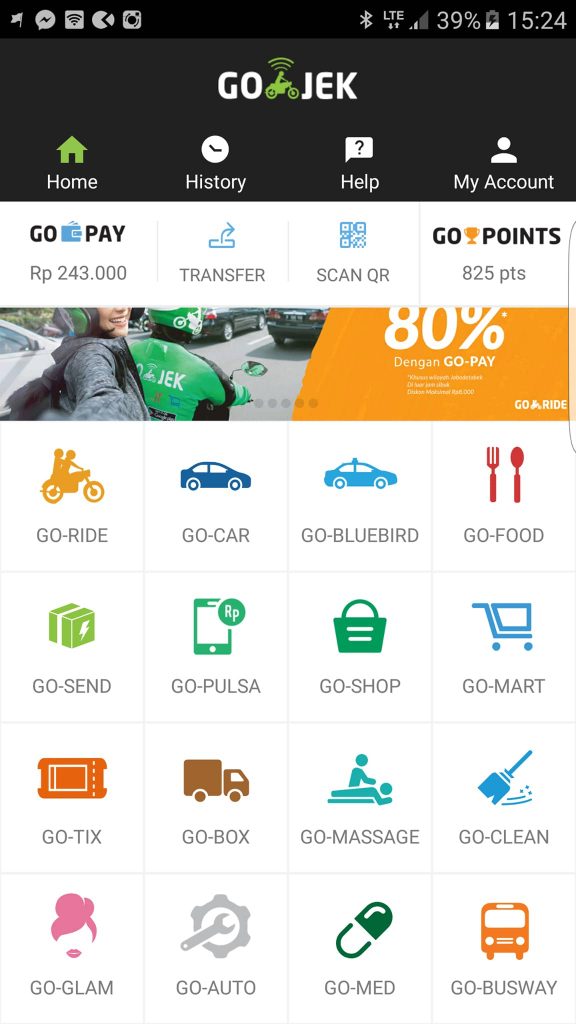
Another interesting fact is the use of their mobile payment system Go-Pay, which is used not only for services included in the app but through other platforms as well (similar to Android Pay). Others have followed suit in this regard, most notably Grab, another Southeast Asian company present in six countries and a main competitor of Go-Jek.
Other companies we looked at in Indonesia are, of course, Uber and Grab along with two other companies. One of them was Blue Bird Group, Indonesia’s largest taxi operator that suffered after big competitors entered the market and wiped out three-fourths of their market value.
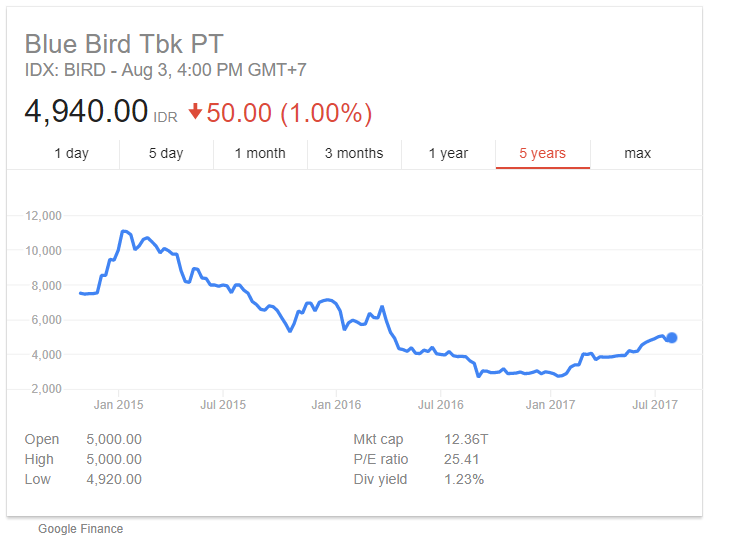
Blue Bird Group market value drop and recovery.
The second is a smaller company, Ojesy Indonesia. The company is specifically targeted for women drivers and riders. With strictly veiled women drivers in the Muslim-majority country, there are a lot of opportunities for growth and adoption by locals.
Here’s why tech companies can’t survive without social media
As mentioned before, Indonesians are very present on different social media channels and are active for long hours every day. For ride-sharing apps, which are B2C businesses, the more visibility and brand recognition they have on social media, the higher market penetration they will attain. Let’s see who’s doing best in this field on social media.
We can see below that Go-Jek Indonesia dominates with regard to the number of fans present on social media platforms. This shows it’s ubiquity in Indonesia. Grab Indonesia comes in second, followed by Blue Bird Group, then Uber. Ojesy Indonesia has the least number of social media fans.

Ride-sharing apps in Indonesia with regard to the number of fans on social media (January to July 2017).
Using Twitter as a primary platform for engagement
Twitter is one of the most active platforms for brands and is where they reply and engage with their fans the most. This is highly beneficial since Twitter is where information can be conveyed quickly and easily.
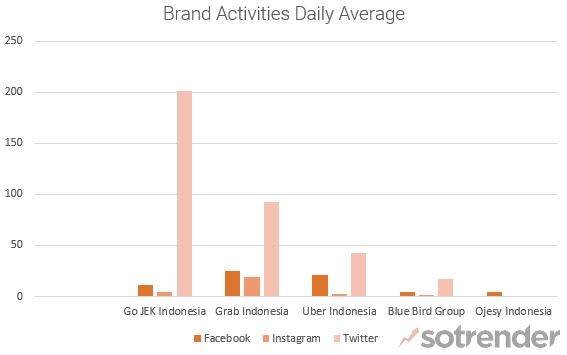
Ride-sharing apps in Indonesia with regard to the average number of daily brand activities (January to July 2017)
Go-Jek Indonesia’s profile has had the highest activity index on Twitter between the analyzed profiles, making it the one users interacted with the most. This can be attributed to their activity on Twitter which was up to 200 actions per day. This includes liking peoples’ replies or replying directly to them.
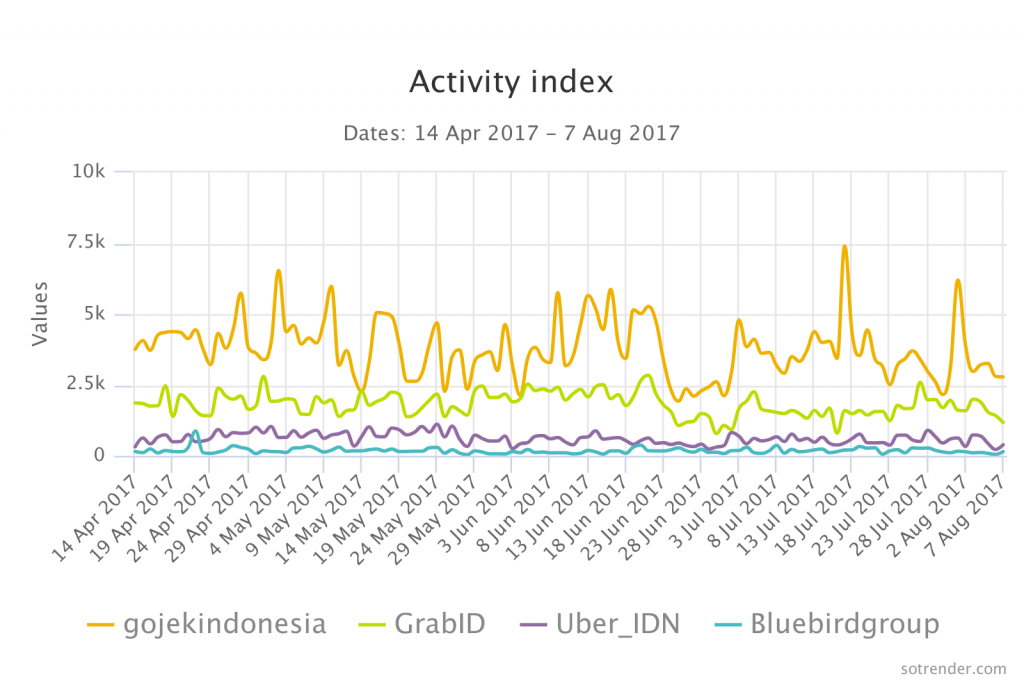
Twitter daily activity index.
As for Facebook, brand activities typically revolve around commenting and posting. Neither is necessarily better than the other, however. Generally, more engagement builds more rapport and trust with the customers.
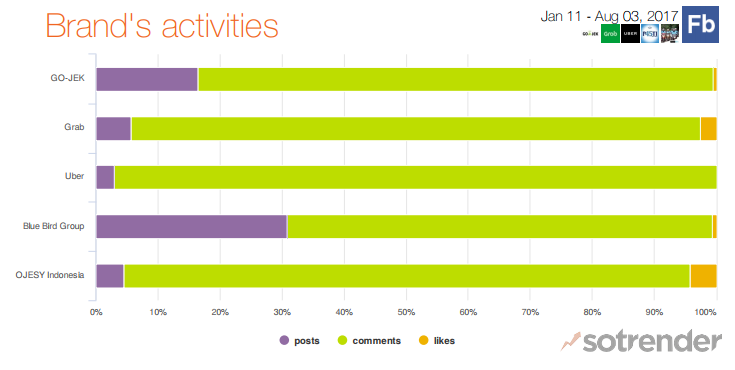
Types of brand activities on Facebook.
Top posts require consistency and a budget
In the below figure, the top posts (taken from the 25 best performing posts) by each brand on social media channels are represented. In total, Grab Indonesia leads with 40 percent of all top posts across Facebook, Twitter, and Instagram over the given time period. Here are the overall rankings:
- Grab Indonesia (40 percent)
- Go-Jek (34.6 percent)
- Uber Indonesia (20 percent)
- Blue Bird Group (5.33 percent)
- Ojesy Indonesia did not have any top performing posts.
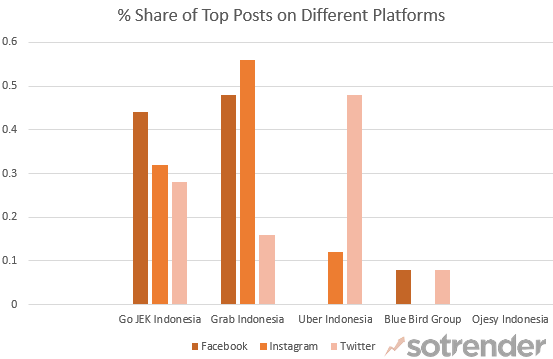
Percent share of top posts on social media (January to July 2017).
Another measure used is the Interactivity Index. This is a weighted score for posts depending on the activities taken by users and the impact they have (e.g. likes have a lower score than comments, but comments have a lower score than shares). Here, Blue Bird Group had the highest score for their post that announced a contest to celebrate their 45th anniversary.
Go-Jek and Grab Indonesia had several peaks throughout the period while Blue Bird Group only had two really high peaks that compared with the rest. Uber also had some decent follow-ups with their own campaigns.
In terms of reach, the best performing post is by Blue Bird Group. The single peak observed here possibly points to a paid campaign. However, as competition/contest posts generally perform well, this is not surprising.
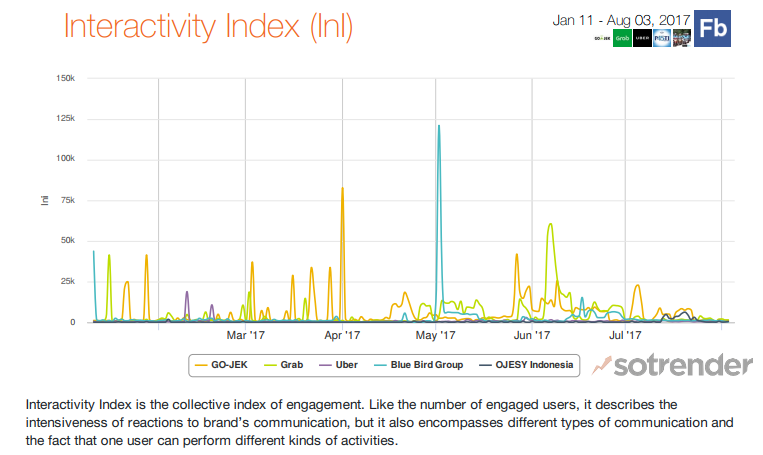
Interactivity index on Facebook.
Indonesians love social media platforms and companies know how to use it
From this analysis, we can see that ride-sharing apps have been capitalizing on the popularity of social media platforms in Indonesia. It also helps that the people using their services are on the platforms consistently and are fairly active there. This promotes more visibility and exposure of their marketing campaigns. Since the customers are usually the end users of the apps, this makes levels of engagement even higher, and a sense of relation to the brand can be achieved if done in the right way.
Source: TechInAsia




